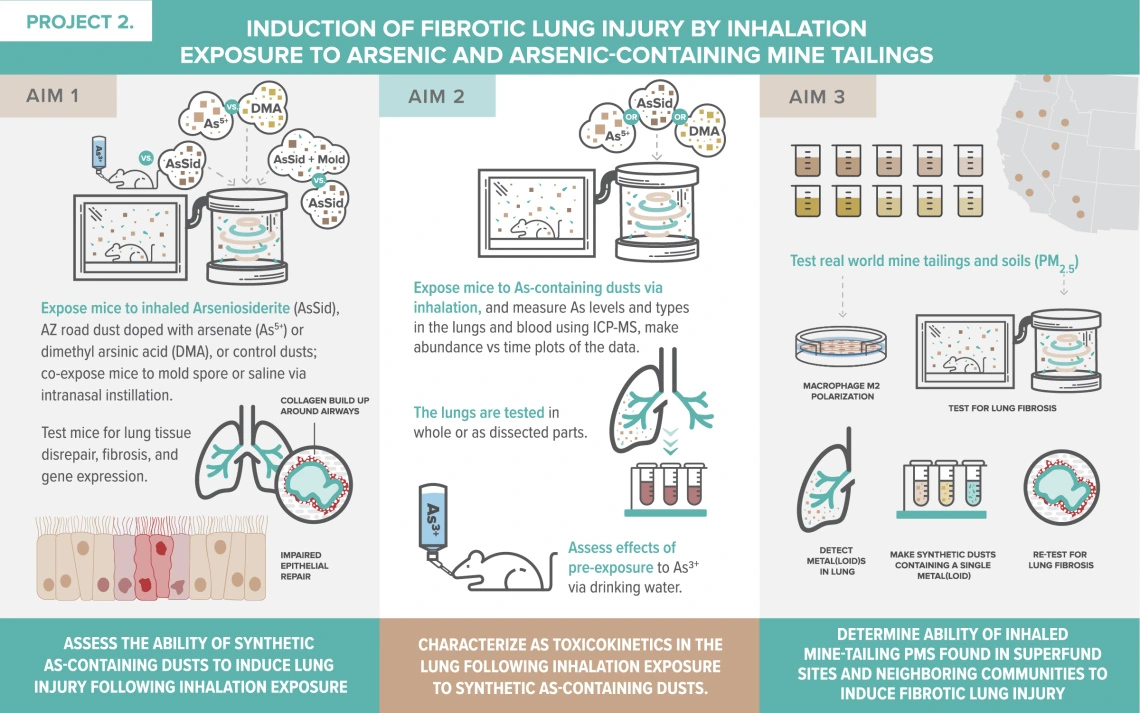
Project Leaders
Summary
Chronic environmental exposure to arsenic (As), the major toxic contaminant in mine tailings (mt), is associated with increased incidence of lung diseases in humans, posing a severe health risk to people living near contaminated sites. Populations residing near mining sites may be chronically exposed to toxic metal(loid)s via the inhalation of dusts and ingestion of contaminated water or food, as the metal(loid)s in the dusts can become bioaccessible. The toxic potential of inhaled As and other metal(loid)s in mine tailings particulate matters (mt- PMs) is unclear, partly due to the lack of knowledge about their bioavailability in the target tissue following inhalation exposure and of studies that associated toxicant levels and types with mt-PMs-induced lung toxicity. Our goal is to discern the toxic potential of inhaled metal(loid)s in mt-PMs by studying toxicokinetics (TK) of the metal(loid) contaminants in an inhalation exposure model of dust-induced lung injury and advance the development of strategies and guidelines for risk detection and disease prevention. This goal and our objectives, to characterize inhalation dust exposure, identify toxicity of individual metal(loid)s in mt-PMs, and test impact of co-exposures to As and mold (fungal spores) on lung health, address the NIEHS SRP Mandates 1 and 2. The potential for inhaled metal(loid)s to reach lung cells is high, as it precedes systemic metabolism and inhalation is a major route for dust exposure. The TK differences between ingestion and inhalation, including differing profiles of metal(loid) species in the lung, provide key rationale for studying the risks of lung injury from inhalation of mt-PMs, particularly PM2.5s, which can accumulate in distal (smaller) airways. As ingestion induces lung fibrosis in rats and mice and As exposure is associated with increased incidence of lung fibrosis in humans. Thus, we will use As-induced fibrotic lung injury as a model to characterize the ability of inhaled As-containing dusts (ACDs) to induce lung injuries and gain insights into the inhalation TK of dust-associated toxic metal(loid)s. Aim 1 hypotheses are: 1) inhaled ACDs are more effective than ingested As in the induction of fibrotic lung injury; 2) inhaled As5+ is more potent than inhaled dimethylarsinic acid (DMA); and 3) co-exposure to fungal spores will exacerbate inhaled ACDs’ toxicity. Aim 2 hypotheses are: 1) greater portions of inhaled As are available to lung cells as As5+ or As3+ rather than DMA, compared to that of ingested As; 2) inhaled As is enriched in distal airways and lung parenchyma; and 3) As ingestion, through inhibition of mucociliary clearance, leads to increased dust persistence in the lung and higher inorganic As levels from ACDs inhalation. Aim 3 will determine the ability of inhaled mt-PMs found in Superfund sites and neighboring communities to induce fibrotic lung injury and identify major non-As metal(loid)s responsible for the toxicity of mt-PMs.






